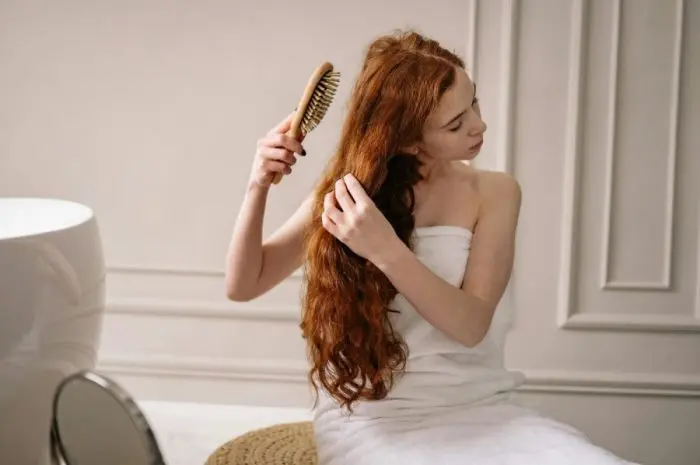Damaged hair can be a source of frustration, affecting not only your appearance but also your confidence. Whether it’s due to heat styling, chemical treatments, environmental factors, or neglect, damaged hair requires special care and attention to restore its health and vitality.
While a trip to the salon may seem like the best solution, there are plenty of effective treatments you can do at home to repair and revitalize your hair. In this comprehensive guide, we’ll explore a variety of DIY treatments and tips for treating damaged hair without having to go to a salon.
1. Assessing the Damage
Before embarking on a hair repair regimen, it’s essential to assess the extent of the damage and identify the specific issues affecting your hair. Common signs of damaged hair include dryness, split ends, breakage, frizz, and dullness. Take a close look at your hair and evaluate its condition to determine the most appropriate course of action.
2. Gentle Cleansing and Conditioning
Start your hair repair routine by cleansing your hair with a gentle shampoo that is free of sulfates and harsh chemicals. Opt for a moisturizing shampoo formulated for damaged hair, and focus on massaging the scalp to stimulate circulation and promote healthy hair growth.
Follow up with a nourishing conditioner to replenish moisture and restore elasticity to your hair. Consider using a deep conditioning treatment or hair mask once a week to provide intensive hydration and repair.
3. Minimize Heat Styling
Excessive heat styling can exacerbate damage and weaken the hair shaft, leading to breakage and dullness. Minimize the use of heat tools such as flat irons, curling irons, and blow dryers, and opt for heat-free styling methods whenever possible.
If you must use heat tools, apply a heat protectant spray or serum to shield your hair from damage and always use the lowest heat setting that achieves your desired style.
4. Trim Regularly
Regular trims are essential for maintaining healthy hair and preventing split ends from traveling up the hair shaft. Schedule regular trims every 6-8 weeks to remove damaged ends and promote healthy growth.
If you’re hesitant to trim your hair yourself, consider investing in a pair of sharp hair scissors and trimming small sections at a time to gradually improve the overall condition of your hair.
5. Use Protein Treatments
Protein treatments are an excellent way to strengthen and repair damaged hair, especially if it has been chemically treated or subjected to frequent styling. Look for protein-rich hair treatments or DIY recipes containing ingredients such as eggs, yogurt, avocado, or coconut oil.
Apply the treatment to clean, damp hair, focusing on the mid-lengths and ends, and leave it on for the recommended time before rinsing thoroughly.
6. Incorporate Oils Into Your Routine
Natural oils are rich in vitamins, antioxidants, and fatty acids that nourish and hydrate the hair, leaving it soft, shiny, and more manageable. Experiment with different oils such as argan oil, coconut oil, jojoba oil, or olive oil to find the best match for your hair type and needs.
Apply a small amount of oil to damp or dry hair, focusing on the ends, and leave it in overnight for maximum hydration and repair.
7. Protect Your Hair From Environmental Damage
Environmental factors such as sun exposure, pollution, and harsh weather conditions can further damage already compromised hair. Protect your hair from environmental damage by wearing a hat or scarf when outdoors, using a UV-protectant spray or serum, and rinsing your hair with fresh water after swimming in chlorinated pools or saltwater.
8. Practice Gentle Styling Techniques
Avoid harsh styling techniques that can stress and damage the hair, such as tight ponytails, braids, or extensions. Opt for loose hairstyles that minimize tension on the hair shaft, and use gentle hair accessories such as soft scrunchies or silk hair ties.
When brushing or combing your hair, use a wide-tooth comb or a brush with soft bristles to prevent breakage and minimize damage.
9. Maintain a Healthy Diet and Lifestyle
Healthy hair starts from within, so be sure to nourish your body with a balanced diet rich in vitamins, minerals, and essential nutrients that support hair health. Stay hydrated by drinking plenty of water, reduce stress through relaxation techniques such as meditation or yoga, and get regular exercise to promote circulation and healthy hair growth.
10. Be Patient and Consistent
Repairing damaged hair takes time, patience, and consistency, so don’t expect overnight results. Be diligent in following your hair repair routine, and be gentle with your hair as it undergoes the healing process. With time and proper care, you’ll begin to notice improvements in the texture, strength, and overall health of your hair.
Conclusion
In conclusion, treating damaged hair at home is entirely possible with the right approach and a bit of dedication. By following these DIY treatments and tips for repairing damaged hair, you can restore luster, vitality, and strength to your locks without having to go to a salon.
Remember to be gentle with your hair, avoid further damage, and practice patience as you embark on your journey to healthier, happier hair. With consistent care and attention, you’ll soon be enjoying the benefits of stronger, shinier, and more resilient locks.

